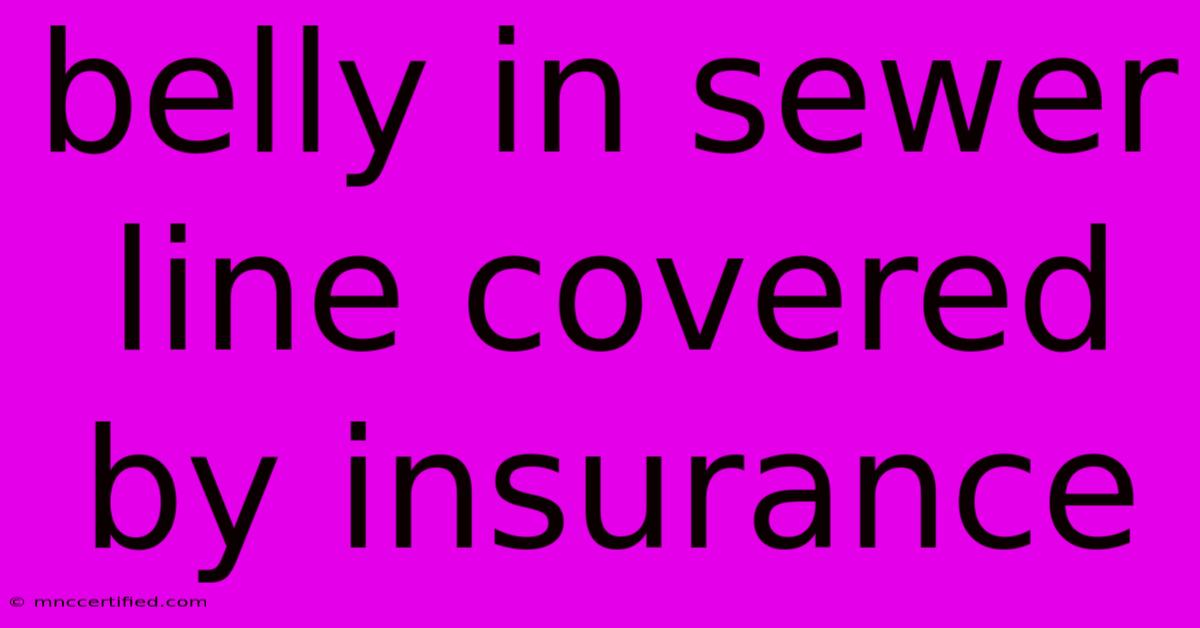Belly In Sewer Line Covered By Insurance

Table of Contents
Belly in Sewer Line: Covered by Insurance? A Comprehensive Guide
A belly in a sewer line is a common plumbing issue, often leading to costly repairs. But what happens when you discover this problem? Is a belly in your sewer line covered by insurance? The answer, unfortunately, isn't always straightforward. This article will explore the factors that influence insurance coverage, help you understand what to do if you encounter this situation, and guide you toward securing the best possible outcome.
Understanding the Basics: Sewer Line Belly
A sewer line belly occurs when a section of the line dips downward, creating a low point where wastewater can collect and potentially back up into your home. This dip can be caused by several factors, including:
- Poor Installation: The initial installation of the sewer line may have been improperly done, leading to the belly.
- Soil Movement: Shifting soil around the line can put pressure on it, creating a dip.
- Tree Roots: Tree roots can grow into and disrupt the sewer line, causing a belly.
- Age & Deterioration: Older sewer lines are more prone to settling and developing a belly over time.
Insurance Coverage: When Does it Apply?
The question of insurance coverage hinges on your specific policy and the cause of the belly.
Here's a breakdown of scenarios:
- If the belly is caused by a sudden, unexpected event:
- Covered: If your sewer line belly is caused by a sudden, unexpected event like a major earthquake, landslide, or severe storm, your homeowners insurance may cover the repairs.
- Not covered: Normal wear and tear, poor installation, or root intrusion are typically not considered covered events.
- If the belly is caused by gradual deterioration:
- Not covered: This is generally not covered by homeowners insurance. Your policy likely only protects against sudden, unexpected events.
Steps to Take When You Suspect a Sewer Line Belly
- Identify the Problem: Look for signs like slow drains, gurgling sounds, sewage backup, or foul odors.
- Call a Licensed Plumber: A qualified plumber can inspect your sewer line and diagnose the issue.
- Document Everything: Take photos and videos of the damage, and keep records of any communication with the plumber and your insurance company.
- File a Claim: Contact your insurance company immediately and explain the situation. They will review your policy and determine coverage.
Important Considerations:
- Policy Review: Carefully examine your homeowners insurance policy to understand your coverage limitations.
- Preventative Maintenance: Regular sewer line inspections and maintenance can help prevent belly formation and other problems.
- Home Warranty: A home warranty can provide coverage for sewer line repairs, even for issues not covered by homeowners insurance.
Final Thoughts
Dealing with a sewer line belly can be a stressful experience. By understanding your insurance policy, taking proper steps, and seeking professional help, you can navigate this situation effectively and secure the necessary repairs. Remember, it's essential to be prepared and proactive, so you are equipped to handle any plumbing emergencies that may arise.

Thank you for visiting our website wich cover about Belly In Sewer Line Covered By Insurance. We hope the information provided has been useful to you. Feel free to contact us if you have any questions or need further assistance. See you next time and dont miss to bookmark.
Featured Posts
-
Trumps Cases Will They Proceed
Nov 07, 2024
-
Who Does Velocity Investments Collect For
Nov 07, 2024
-
Fc Bayern Fans Boost Win Against Benfica
Nov 07, 2024
-
Is Sump Pump Failure Covered By Insurance
Nov 07, 2024
-
History In The Making Vances Wife As Second Lady
Nov 07, 2024